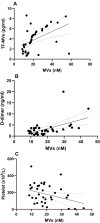Procoagulant Microvesicles in COVID-19 Patients: Possible Modulators of Inflammation and Prothrombotic Tendency
- PMID: 35517897
- PMCID: PMC9064482
- DOI: 10.2147/IDR.S355395
Procoagulant Microvesicles in COVID-19 Patients: Possible Modulators of Inflammation and Prothrombotic Tendency
Abstract
Background: The hypercoagulability and thrombotic tendency in coronavirus disease 2019 (COVID-19) is multifactorial, driven mainly by inflammation, and endothelial dysfunction. Elevated levels of procoagulant microvesicles (MVs) and tissue factor-bearing microvesicles (TF-bearing MVs) have been observed in many diseases with thrombotic tendency. The current study aimed to measure the levels of procoagulant MVs and TF-bearing MVs in patients with COVID-19 and healthy controls and to correlate their levels with platelet counts, D-Dimer levels, and other proposed calculated inflammatory markers.
Materials and methods: Forty ICU-admitted patients with COVID-19 and 37 healthy controls were recruited in the study. Levels of procoagulant MVs and TF-bearing MVs in the plasma of the study population were measured using enzyme linked immunosorbent assay.
Results: COVID-19 patients had significantly elevated levels of procoagulant MVs and TF-bearing MVs as compared with healthy controls (P<0.001). Procoagulant MVs significantly correlated with TF-bearing MVs, D-dimer levels, and platelet count, but not with calculated inflammatory markers (neutrophil/lymphocyte ratio, platelet/lymphocyte ratio, and platelet/neutrophil ratio).
Conclusion: Elevated levels of procoagulant MVs and TF-bearing MVs in patients with COVID-19 are suggested to be (i) early potential markers to predict the severity of COVID-19 (ii) a novel circulatory biomarker to evaluate the procoagulant activity and severity of COVID-19.
Keywords: COVID-19; D-dimer; NLR; PLR; PNR; microvesicles; procoagulant; tissue factor.
© 2022 Hamali et al.
Conflict of interest statement
The authors have read the journal’s policy and declare no conflict of interest.
Figures


Similar articles
-
Elevated Levels of Procoagulant Microvesicles and Tissue-Factor Bearing Microvesicles in Malaria Patients.Int J Gen Med. 2023 Apr 5;16:1205-1215. doi: 10.2147/IJGM.S402212. eCollection 2023. Int J Gen Med. 2023. PMID: 37041799 Free PMC article.
-
Evaluation of circulating microvesicles and their procoagulant activity in patients with COVID-19.BMC Res Notes. 2024 Aug 22;17(1):233. doi: 10.1186/s13104-024-06875-9. BMC Res Notes. 2024. PMID: 39175048 Free PMC article.
-
IL-33 stimulates the release of procoagulant microvesicles from human monocytes and differentially increases tissue factor in human monocyte subsets.Thromb Haemost. 2017 Jun 28;117(7):1379-1390. doi: 10.1160/TH16-10-0784. Epub 2017 May 11. Thromb Haemost. 2017. PMID: 28492698
-
Microvesicles as risk markers for venous thrombosis.Expert Rev Hematol. 2013 Feb;6(1):91-101. doi: 10.1586/ehm.12.74. Expert Rev Hematol. 2013. PMID: 23373784 Review.
-
Microvesicles and Cancer Associated Thrombosis.Semin Thromb Hemost. 2019 Sep;45(6):593-603. doi: 10.1055/s-0039-1693476. Epub 2019 Aug 20. Semin Thromb Hemost. 2019. PMID: 31430786 Review.
Cited by
-
Elevated Levels of Procoagulant Microvesicles and Tissue-Factor Bearing Microvesicles in Malaria Patients.Int J Gen Med. 2023 Apr 5;16:1205-1215. doi: 10.2147/IJGM.S402212. eCollection 2023. Int J Gen Med. 2023. PMID: 37041799 Free PMC article.
-
Comparative Analysis of Red Blood Cells, White Blood Cells, Platelet Count, and Indices in Type 2 Diabetes Mellitus Patients and Normal Controls: Association and Clinical Implications.Diabetes Metab Syndr Obes. 2023 Oct 6;16:3123-3132. doi: 10.2147/DMSO.S422373. eCollection 2023. Diabetes Metab Syndr Obes. 2023. PMID: 37822802 Free PMC article.
-
Challenges with measuring tissue factor antigen and activity in human plasma.Blood Vessel Thromb Hemost. 2024 Jul 31;1(4):100022. doi: 10.1016/j.bvth.2024.100022. eCollection 2024 Dec. Blood Vessel Thromb Hemost. 2024. PMID: 40765933 Free PMC article. Review.
-
Evaluation of circulating microvesicles and their procoagulant activity in patients with COVID-19.BMC Res Notes. 2024 Aug 22;17(1):233. doi: 10.1186/s13104-024-06875-9. BMC Res Notes. 2024. PMID: 39175048 Free PMC article.
-
Extracellular vesicles are a late marker of inflammation, hypercoagulability and COVID-19 severity.Hematol Transfus Cell Ther. 2024 Apr-Jun;46(2):176-185. doi: 10.1016/j.htct.2023.12.003. Epub 2024 Feb 1. Hematol Transfus Cell Ther. 2024. PMID: 38341321 Free PMC article.
References
LinkOut - more resources
Full Text Sources
Miscellaneous

